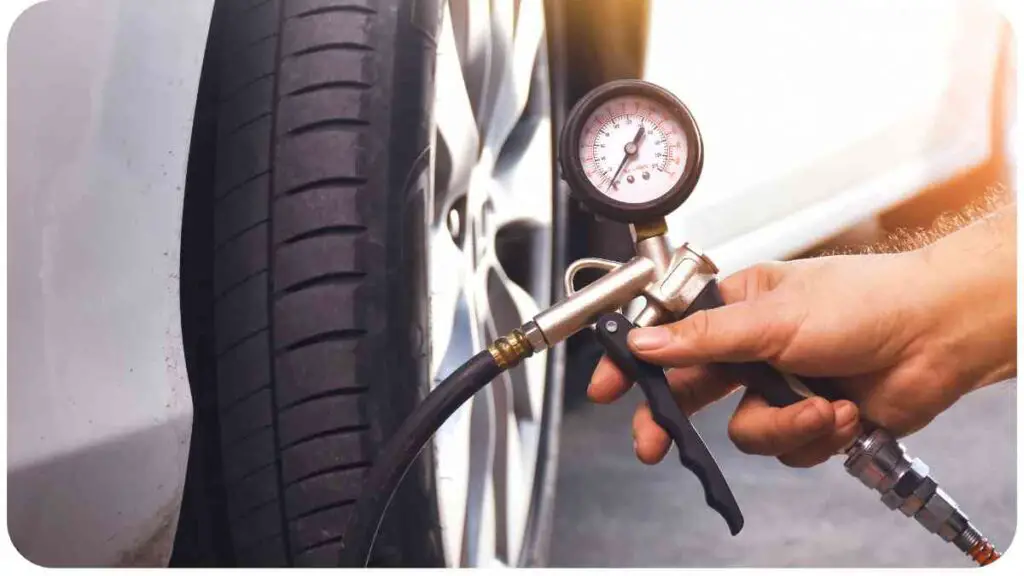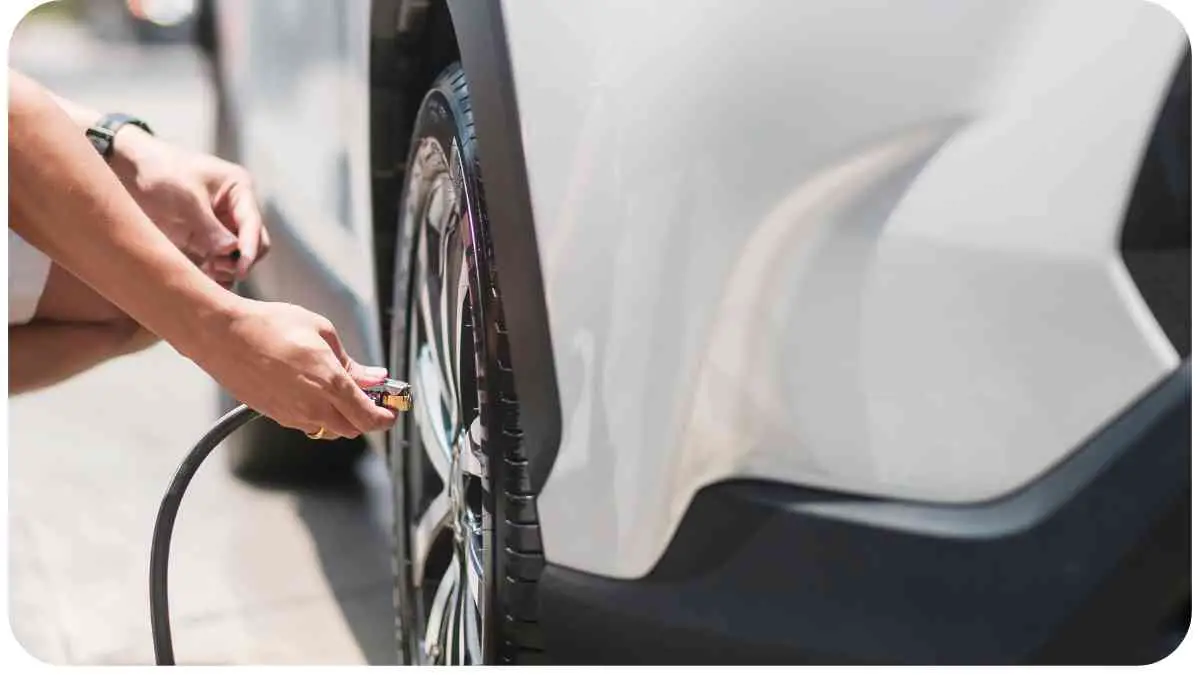As an off-road enthusiast, the proper inflation of your vehicle’s tires is crucial for maintaining safety, maximizing performance, and conserving fuel. In this guide, we will delve into the importance of correct tire inflation and provide you with a step-by-step process to ensure your off-road vehicle’s tires are properly inflated.
| Takeaways |
| Importance of proper tire inflation for off-road vehicles |
| Tire safety, vehicle performance, and fuel efficiency are impacted by tire pressure |
| Follow the manufacturer’s recommended tire pressure |
| Regularly check tire pressure to maintain optimal performance |
| Consider temperature changes and adjust tire pressure accordingly |
| Avoid overinflating or underinflating tires |
| Don’t neglect the spare tire |
| Uneven tire inflation can affect vehicle handling and safety |
2. Importance of Proper Tire Inflation
2.1 Tire Safety
Ensuring your off-road vehicle’s tires are correctly inflated significantly contributes to your safety on the trails. Overinflated or underinflated tires can impact your vehicle’s handling, stability, and braking capabilities. Proper tire inflation helps minimize the risk of blowouts, punctures, and accidents while traversing rough terrain.
Proper tire rotation is crucial to extending tire life. Neglecting it can lead to uneven wear, affecting off-road performance and safety. Learn how to rotate your off-road vehicle’s tires correctly for optimal results.
2.2 Vehicle Performance
Correct tire inflation is directly related to the performance of your off-road vehicle. By maintaining the recommended tire pressure, you can optimize traction, maneuverability, and control. Well-inflated tires provide better grip on varying surfaces, allowing you to navigate obstacles with greater ease and confidence.
2.3 Fuel Efficiency
Properly inflated tires also contribute to better fuel efficiency. Underinflated tires increase rolling resistance, requiring your engine to work harder and consume more fuel. By keeping your tires at the right pressure, you can optimize your off-road vehicle’s fuel consumption, improving your range and reducing the frequency of refueling.
The choice of off-road tires can make a significant difference in your vehicle’s performance. Check out this comprehensive guide on selecting the right off-road tire to ensure the best grip and durability for your adventures.
3. Understanding Tire Pressure
3.1 Recommended Tire Pressure
Each off-road vehicle has a specific tire pressure recommendation provided by the manufacturer. This information is usually found in the owner’s manual or on a sticker located on the driver’s side door jamb. It is essential to follow these guidelines to ensure optimal performance and safety.
3.2 Factors Affecting Tire Pressure
Tire pressure is affected by various factors, including temperature, load, and terrain. As an off-road enthusiast, you may encounter extreme weather conditions and rugged terrains that impact tire pressure. It is crucial to monitor and adjust tire pressure accordingly to handle these challenging environments effectively.
| Factors Affecting Tire Pressure |
| Temperature fluctuations |
| Vehicle load and cargo |
| Rough or uneven terrains |
| Altitude changes |
| Off-road driving conditions |
4. Tools Needed for Tire Inflation

Before you begin inflating your off-road vehicle’s tires, it’s important to gather the necessary tools to ensure a successful process.
Maintaining the right tire pressure is essential for ATV performance. Discover a comprehensive guide on understanding and adjusting ATV tire pressure. It will help you enhance your ATV’s handling and extend tire life.
4.1 Tire Pressure Gauge
A reliable tire pressure gauge is essential for accurate tire pressure measurements. Digital or analog gauges are commonly available, and it is advisable to choose one that suits your preference and provides precise readings.
4.2 Air Compressor
To inflate your off-road vehicle’s tires, an air compressor is necessary. Portable air compressors with sufficient airflow capacity are a popular choice among off-road enthusiasts, allowing for convenient and efficient tire inflation.
4.3 Valve Stem Caps
Valve stem caps are small but important components that help maintain tire pressure. They prevent dirt, dust, and moisture from entering the valve stem, reducing the chances of air leaks and maintaining proper inflation over extended periods.
Getting stuck with a punctured off-road tire can be frustrating. Follow our step-by-step guide on how to fix a punctured off-road tire to get back on the trail quickly and safely. Don’t let a flat tire ruin your adventure!
5. Step-by-Step Guide to Tire Inflation
Now that you have gathered the necessary tools, let’s walk through the process of correctly inflating your off-road vehicle’s tires.
5.1 Checking the Current Tire Pressure
Before inflating your tires, it’s important to know the current tire pressure. Using a tire pressure gauge, remove the valve stem cap from each tire and firmly press the gauge onto the valve stem. The gauge should provide an accurate reading of the tire pressure. Take note of the measurements as a reference point.
5.2 Removing Debris and Obstacles
Inspect your tires for any debris or obstacles that may hinder the proper inflation process. Look for stones, twigs, or other objects lodged in the treads. Clear out any foreign materials to ensure a clean and reliable connection between the valve stem and the tire pressure gauge during inflation.
5.3 Connecting the Air Compressor
Attach the air compressor hose securely to the valve stem of the first tire. Ensure a tight connection to prevent air leaks. If your air compressor has a built-in pressure regulator, set it to your desired tire pressure. If not, you will need to monitor the pressure manually while inflating.
Mud can be a challenge for off-road vehicles. Learn about the common reasons your off-road vehicle may get stuck in mud and discover effective solutions to tackle this common off-road obstacle. Stay prepared and enjoy your off-roading adventures without worries.
5.4 Inflating the Tires
Switch on the air compressor and allow it to fill the tire with air. Keep an eye on the pressure gauge to ensure you reach the desired tire pressure. As you approach the recommended pressure, it’s important to make incremental adjustments and check the pressure frequently to avoid overinflation.
5.5 Checking the Final Tire Pressure
After inflating a tire to the recommended pressure, disconnect the air compressor and use the tire pressure gauge to confirm the final tire pressure. Repeat this process for each tire, ensuring that they all reach the appropriate pressure level.
| Step | Action |
| 1 | Check the current tire pressure |
| 2 | Remove debris and obstacles from the tires |
| 3 | Connect the air compressor hose securely |
| 4 | Inflating the tires, monitoring the pressure closely |
| 5 | Check the final tire pressure |
6. Tips for Correct Tire Inflation

To maintain proper tire inflation for your off-road vehicle, consider the following tips:
6.1 Regular Tire Pressure Checks
Make it a habit to check your tire pressure regularly, especially before embarking on off-road adventures. Regular inspections will help you detect and rectify any issues promptly, ensuring optimal performance and safety.
6.2 Consider Temperature Changes
Temperature fluctuations can affect tire pressure. As you venture into different environments, monitor the changes in temperature and adjust your tire pressure accordingly. Cold temperatures can cause tire pressure to decrease, while hot temperatures can lead to increased pressure.
6.3 Avoid Overinflating or Underinflating
Both overinflating and underinflating your off-road vehicle’s tires can have adverse effects. Overinflation may result in a harsh and uncomfortable ride, decreased traction, and susceptibility to punctures. Underinflation can lead to poor fuel efficiency, reduced steering response, and increased tire wear. It’s vital to adhere to the recommended tire pressure.
7. Common Mistakes to Avoid
While inflating your off-road vehicle’s tires, it’s important to be aware of common mistakes that can compromise the effectiveness of the process. Avoiding these mistakes will help ensure that your tires are properly inflated and ready for your off-road adventures.
7.1 Reliance on Visual Inspection
Relying solely on visual inspection to determine tire pressure is a common mistake. Tires can appear to be properly inflated, but the actual pressure may be different. It’s crucial to use a reliable tire pressure gauge to obtain accurate readings and make appropriate adjustments.
7.2 Neglecting Spare Tire
Don’t forget to check and inflate your spare tire. It’s often overlooked, but having a properly inflated spare tire is essential for maintaining your off-road vehicle’s safety and readiness. Include the spare tire in your regular tire pressure checks and ensure it is inflated to the recommended pressure.
7.3 Uneven Tire Inflation
Inconsistent tire pressure across your off-road vehicle’s tires can affect its performance and safety. Make sure to inflate each tire to the recommended pressure levels. Uneven inflation can result in imbalanced handling, reduced traction, and premature tire wear.
| Common Mistakes | Consequences |
| Relying on visual inspection | Inaccurate tire pressure |
| Neglecting spare tire | Lack of readiness in case of emergencies |
| Uneven tire inflation | Compromised performance and safety |
8. Conclusion
Properly inflating your off-road vehicle’s tires is essential for ensuring safety, maximizing performance, and conserving fuel. By following the step-by-step guide provided in this article, you can confidently and correctly inflate your tires. Remember to regularly check your tire pressure, consider external factors, and avoid common mistakes.
Maintaining the correct tire inflation will enhance your off-road adventures, allowing you to tackle challenging terrains with confidence and peace of mind. Stay safe, enjoy the journey, and keep your tires properly inflated for a thrilling and rewarding off-roading experience.
Further Reading
Here are some additional resources to further enhance your knowledge about correctly inflating your off-road vehicle’s tires:
- Firestone Complete Auto Care: Car Tire Inflation – This blog post provides detailed information on car tire inflation, including the importance of proper tire pressure, how to check tire pressure, and tips for maintaining the correct pressure.
- Jaco Superior Products: Your Ultimate Guide to Off-Roading Tire Pressure – Dive into this comprehensive guide that covers everything you need to know about off-roading tire pressure. Learn about the recommended pressures, factors to consider, and tips for finding the optimal tire pressure for off-road adventures.
- Driving Line: Best Ways to Air Back Up After Off-Roading – After exploring off-road terrains, it’s important to know how to air back up your tires. This article discusses various methods and tools for quickly and efficiently inflating your tires and getting back on the road.
FAQs
Here are some frequently asked questions about correctly inflating off-road vehicle tires:
How often should I check my tire pressure?
Regular tire pressure checks are recommended, and it’s advised to check your tire pressure at least once a month and before embarking on any off-road trips. Proper inflation is crucial for optimal performance and safety.
Can I rely on visual inspection to determine tire pressure?
Visual inspection alone is not accurate enough to determine tire pressure. It’s essential to use a tire pressure gauge for precise readings as tires can appear properly inflated while having an incorrect pressure.
Should I adjust my tire pressure for different terrains?
Yes, you may need to adjust your tire pressure based on the terrains you encounter during off-roading. Lowering tire pressure can enhance traction on soft surfaces like sand or mud, while raising it can provide better stability on rocky or uneven terrains.
How does temperature affect tire pressure?
Temperature fluctuations can significantly impact tire pressure. Cold temperatures cause tire pressure to decrease, while hot temperatures can increase it. It’s important to consider these changes and make necessary adjustments to maintain optimal tire pressure.
Can I use the same tire pressure for all four tires?
Each tire plays a crucial role in vehicle performance and handling. It’s recommended to inflate all tires to the manufacturer’s recommended pressure to ensure balanced performance. Uneven tire pressure can lead to imbalanced handling and potential safety issues.

Hi there! I’m Hellen James, and I’m the author of Unified Off-roads. I’ve been driving off-road for more than ten years, and I’ve had a lot of fun in that time—and a few not-so-great experiences too. But I’ve always wanted to help other people get started off-roading, so I decided to start this blog to share my knowledge with others.


